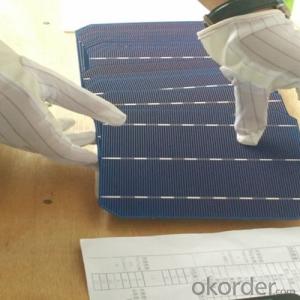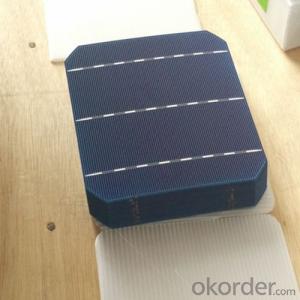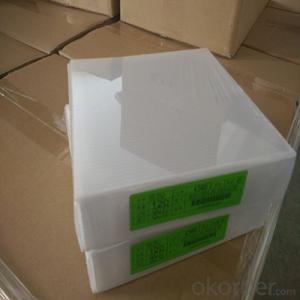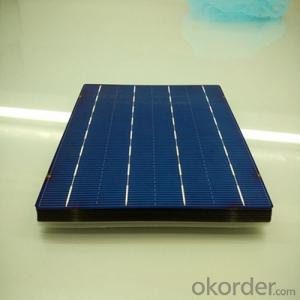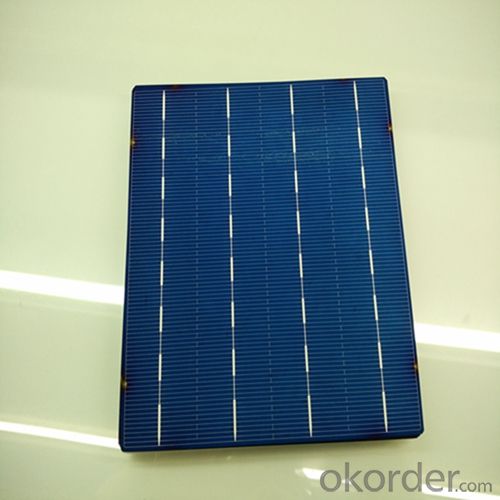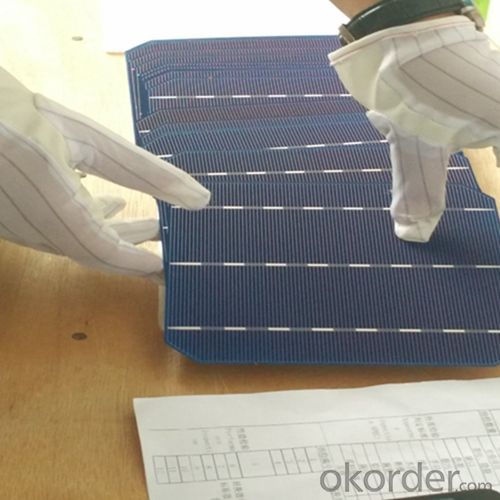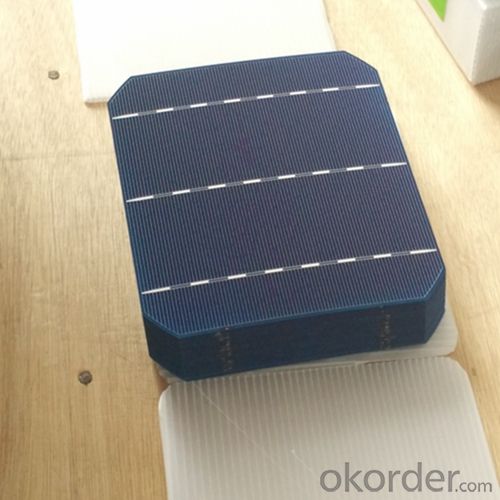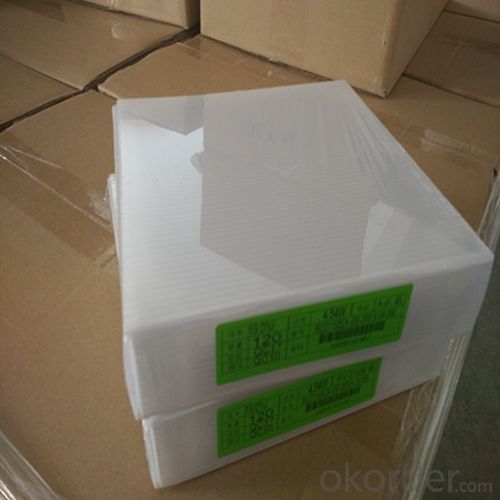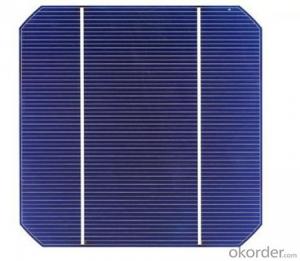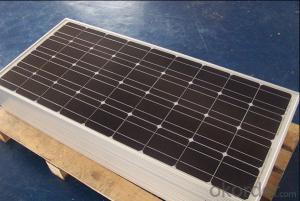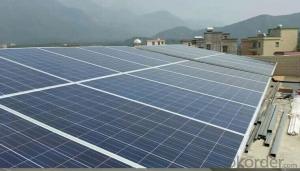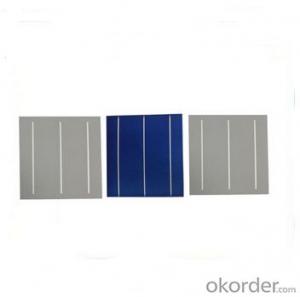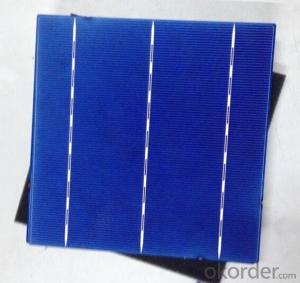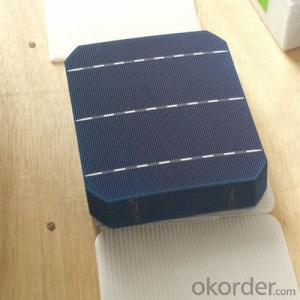Printable Organic Solar Cells - Poly 156mm x 156mm Solar Cells for Sale at Lowest Prices
- Loading Port:
- Shanghai
- Payment Terms:
- TT or LC
- Min Order Qty:
- 4999 watt
- Supply Capability:
- 6000000 watt/month
OKorder Service Pledge
OKorder Financial Service
You Might Also Like
The operation of a photovoltaic (PV) cell requires 3 basic attributes:
The absorption of light, generating either electron-hole pairs or excitons.
The separation of charge carriers of opposite types.
The separate extraction of those carriers to an external circuit.
In contrast, a solar thermal collector supplies heat by absorbing sunlight, for the purpose of either direct heating or indirect electrical power generation from heat. A "photoelectrolytic cell" (photoelectrochemical cell), on the other hand, refers either to a type of photovoltaic cell (like that developed by Edmond Becquerel and modern dye-sensitized solar cells), or to a device that splits water directly into hydrogen and oxygen using only solar illumination.Characteristic of Mono 156X156MM2 Solar Cells
You are gaining energy independence - add battery backup power for even greater energy security
The cost of electricity is only going to rise – insure against that rising cost
Adaptive cells change their absorption/reflection characteristics depending to respond to environmental conditions. An adaptive material responds to the intensity and angle of incident light. At the part of the cell where the light is most intense, the cell surface changes from reflective to adaptive, allowing the light to penetrate the cell. The other parts of the cell remain reflective increasing the retention of the absorbed light within the cell.[67]
In 2014 a system that combined an adaptive surface with a glass substrate that redirect the absorbed to a light absorber on the edges of the sheet. The system also included an array of fixed lenses/mirrors to concentrate light onto the adaptive surface. As the day continues, the concentrated light moves along the surface of the cell. That surface switches from reflective to adaptive when the light is most concentrated and back to reflective after the light moves along
Mechanical data and design
Format | 156mm x 156mm±0.5mm |
Thickness | 210μm±40μm |
Front(-) | 1.5mm bus bar (silver),blue anti-reflection coating (silicon nitride) |
Back (+) | 2.5mm wide soldering pads (sliver) back surface field (aluminium) |
Temperature Coefficient of Cells
Voc. Temp.coef.%/K | -0.35% |
Isc. Temp.coef .%/K | +0.024%/K |
Pm.Temp.coef. %/K | -0.47%/K |
Electrical Characteristic
Effiency(%) | Pmpp(W) | Umpp(V) | Impp(A) | Uoc(V) | Isc(A) | FF(%) |
18.35 | 4.384 | 0.526 | 8.333 | 0.63 | 8.877 | 78.39% |
18.20 | 4.349 | 0.526 | 8.263 | 0.63 | 8.789 | 78.54% |
18.05 | 4.313 | 0.525 | 8.216 | 0.63 | 8.741 | 78.32% |
17.90 | 4.277 | 0.524 | 8.161 | 0.625 | 8.713 | 78.04% |
17.75 | 4.241 | 0.523 | 8.116 | 0.625 | 8.678 | 77.70% |
17.60 | 4.206 | 0.521 | 8.073 | 0.625 | 8.657 | 77.36% |
17.45 | 4.170 | 0.519 | 8.039 | 0.625 | 8.633 | 76.92% |
17.30 | 4.134 | 0.517 | 8.004 | 0.625 | 8.622 | 76.59% |
17.15 | 4.096 | 0.516 | 7.938 | 0.625 | 8.537 | 76.80% |
17.00 | 4.062 | 0.512 | 7.933 | 0.625 | 8.531 | 76.18% |
16.75 | 4.002 | 0.511 | 7.828 | 0.625 | 8.499 | 75.34% |
16.50 | 3.940 | 0.510 | 7.731 | 0.625 | 8.484 | 74.36% |
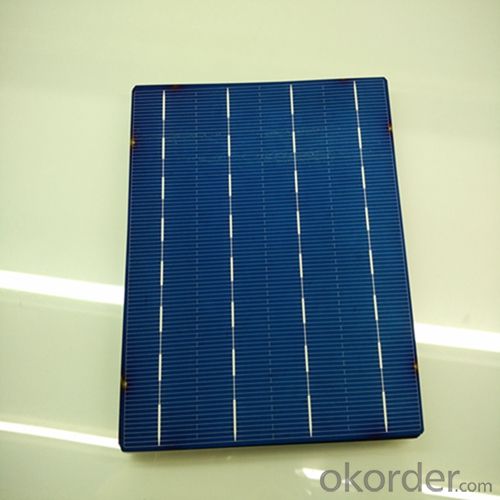
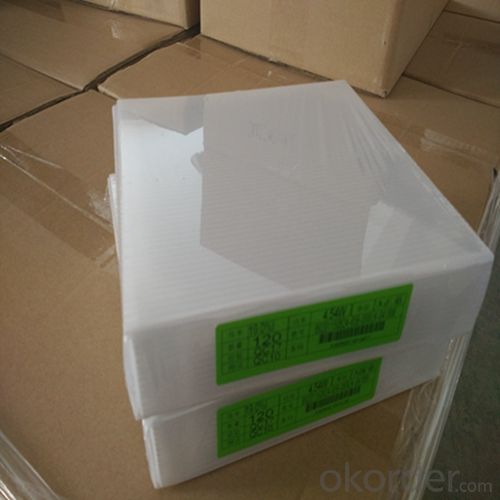
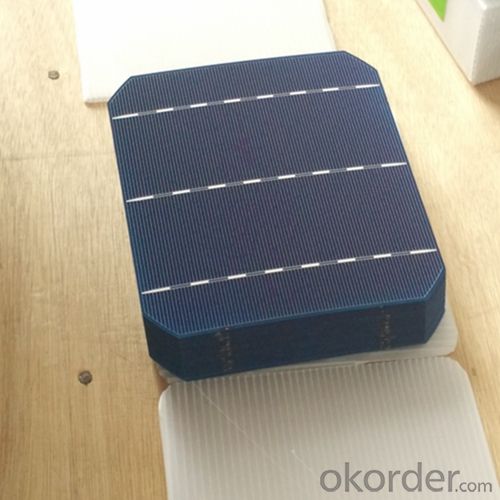
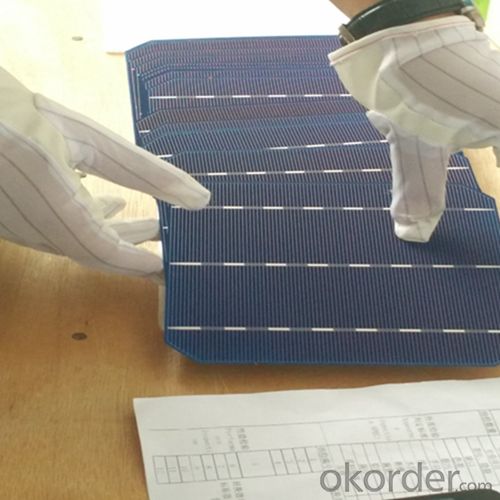
 FAQ
FAQ
Q: What price for each watt?
A: It depends on the quantity, delivery date and payment terms, generally Large Quantity and Low Price
Q: What is your size for each module? Can you tell me the Parameter of your module?
A: We have different series of panels in different output, both c-Si and a-Si. Please take the specification sheet for your reference.
Q: What is your size for each module? Can you tell me the Parameter of your module?
A: We have different series of panels in different output, both c-Si and a-Si. Please take the specification sheet for your reference.
Solar cells through the photoelectric effect or photochemical effect directly convert light into electrical energy. In the photoelectric effect of thin-film solar cells work for the mainstream, how to buy solar cells haunt some people. This article briefly describes the knowledge about the solar optional. Hope it helps you.
Solar cells currently on the market are divided into amorphous and crystalline silicon. Where in the crystalline silicon can be divided into polycrystalline silicon and monocrystalline silicon. From the photoelectric conversion efficiency of the three materials of view: monocrystalline silicon (up to 17%)> polycrystalline silicon (12 to 15%)> amorphous silicon (about 5%). However, crystalline silicon (monocrystalline and polycrystalline) in low light to produce substantially no current, low-light-type amorphous silicon is better (in low light energy is inherently less). In general, it is more suitable to use silicon or polycrystalline silicon solar cell materials.
Selection Method of solar cell for sale
When we buy a solar cell, the focus is proportional to the area of solar power cells, in general, solar panel power with solar wafers concern. Solar cell area of the wafer is not exactly the same as the solar panel area of the package, because some solar panels though large, single-slot wide array of solar wafers, solar panels such power are not necessarily high.
Generally speaking, solar panel power is the bigger the better, so that the current produced under the sun will be large, built-in battery can be filled quickly. But in reality, a balance should be found in the need for solar panels and solar power portable charger. Solar power charger is generally considered the minimum of not less than 0.75w, secondary power solar panel under the standard light there is 140mA of current. In general, the current generated by the sun is about 100mA, if less than the second power charge current is too small, basically there will be no significant effect.
- Q: How do solar cells perform in regions with frequent thunderstorms?
- Solar cells are not directly affected by thunderstorms themselves. However, frequent thunderstorms in a region can lead to reduced sunlight exposure, which may affect the overall performance of solar cells.
- Q: How do solar cells handle partial shading?
- Solar cells handle partial shading by using bypass diodes. These diodes allow the current to bypass the shaded area, ensuring that the rest of the solar cell continues to function efficiently. By redirecting the current, the solar cells can still generate power even if some parts are shaded, minimizing the impact of partial shading on overall performance.
- Q: Can solar cells be used in cloudy or rainy weather?
- Yes, solar cells can still be used in cloudy or rainy weather. While their efficiency may be reduced, they can still generate electricity from diffuse sunlight or indirect light. However, their performance will be optimal in direct sunlight.
- Q: Can solar cells be used to power refrigeration systems?
- Yes, solar cells can be used to power refrigeration systems. Solar cells convert sunlight into electricity, which can be used to power various appliances and systems, including refrigeration systems. This method of powering refrigeration systems is environmentally friendly and sustainable.
- Q: What is the impact of bird droppings on solar cell efficiency?
- Bird droppings can have a negative impact on solar cell efficiency as they can block sunlight from reaching the surface of the cells, reducing their ability to generate electricity. Additionally, the acidic nature of bird droppings can cause damage to the protective coatings on the solar cells, further decreasing their efficiency. Regular cleaning and maintenance are necessary to mitigate the effects of bird droppings on solar cell performance.
- Q: Can solar cells be used in recreational vehicles (RVs)?
- Yes, solar cells can be used in recreational vehicles (RVs). Installing solar panels on the roof of an RV can provide a sustainable and efficient source of electricity for powering various appliances and devices while on the road. This allows RV owners to reduce their reliance on traditional power sources and enjoy greater freedom and flexibility in their travels.
- Q: How are solar cells used in agricultural applications?
- Solar cells are used in agricultural applications to generate electricity for various purposes, such as powering irrigation systems, lighting in greenhouses, and running equipment like pumps and fans. They help farmers reduce their reliance on traditional energy sources and promote sustainable farming practices.
- Q: How do solar cells affect the environment?
- Solar cells have a positive impact on the environment as they produce clean and renewable energy, reducing the reliance on fossil fuels and lowering greenhouse gas emissions. Additionally, the production and operation of solar cells have minimal environmental impact compared to conventional power generation methods. However, the manufacturing process of solar cells does require some resources and can generate waste, but overall, the environmental benefits outweigh these concerns.
- Q: What is the impact of wind on solar cell performance?
- The impact of wind on solar cell performance can be both positive and negative. On one hand, wind can help to cool down the solar panels, preventing them from overheating and maintaining their efficiency. Additionally, a gentle breeze can help to disperse any accumulated dust or debris on the panels, ensuring maximum sunlight absorption. On the other hand, strong winds can create vibrations that may damage the solar panels or the mounting structure, leading to potential performance degradation or even system failure. Therefore, while some wind can be beneficial, it is important to properly design and install solar panels to withstand and minimize any negative impact from strong winds.
- Q: Solar cell life for several years
- Photoelectric effect of the work of thin film solar cells as the mainstream, and the implementation of photochemical effects of solar cells is still in the embryonic stage.
Send your message to us
Printable Organic Solar Cells - Poly 156mm x 156mm Solar Cells for Sale at Lowest Prices
- Loading Port:
- Shanghai
- Payment Terms:
- TT or LC
- Min Order Qty:
- 4999 watt
- Supply Capability:
- 6000000 watt/month
OKorder Service Pledge
OKorder Financial Service
Similar products
Hot products
Hot Searches
Related keywords

